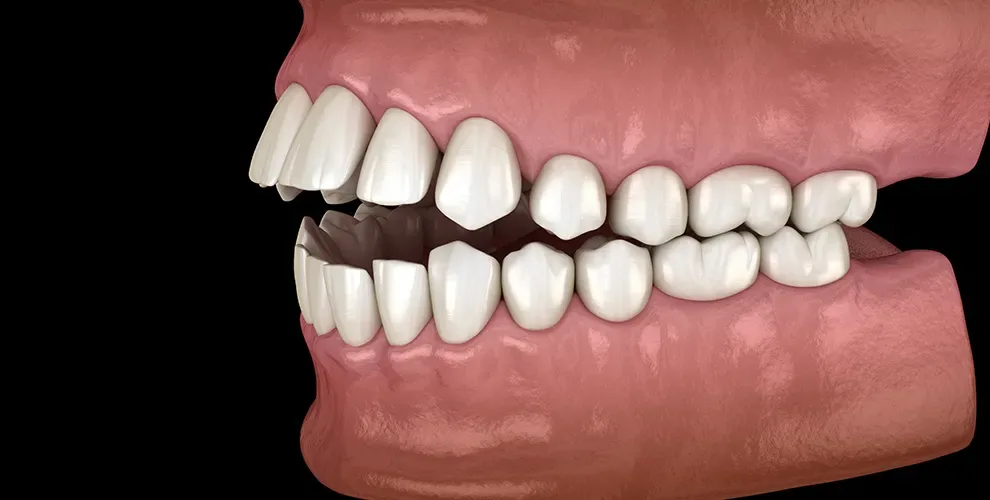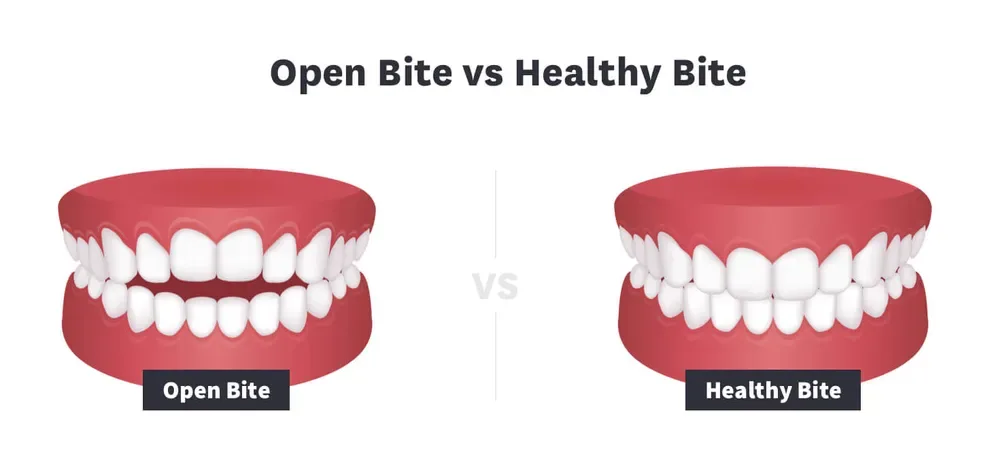Fixing an Open Bite: Are Braces the Only Answer?

Table of Contents
- What is an Open Bite?
- Types of Open Bite
- Causes
- Treatment
- Treatment Cost
- Health Risks for Non-Treatment
- Diagnosis
- Insurance
- Open Bite FAQs
An open bite is a type of malocclusion (teeth misalignment). With an open bite, there is a gap between the upper and lower teeth when the mouth is closed. This may be caused by genetics, oral habits (like tongue thrusting or pacifier use as a child), or injury.
An open bite can cause problems that include decay, speech problems, difficulty chewing, and weakened tooth enamel.
Serious cases of open bite that are caused by a skeletal problem or jaw positioning may require jaw surgery. Other treatment options may include braces, orthodontic appliances (such as palatal expanders), and clear aligners.

What is an Open Bite?
When teeth are properly aligned, the upper teeth will fit comfortably just over the lower teeth when the mouth is closed. The grooves and tops of opposing molars will line up to fit together.
With an open bite, some of the upper and lower teeth do not connect when the mouth is closed. There is still a gap and in places, the upper and lower teeth are not touching.
An open bite is a form of a malocclusion, or tooth misalignment. Malocclusion is common and open bites are particularly difficult to live with, as they can have a serious impact on important daily activities like chewing, talking, and taking care of your gums and teeth.
What are the Types of Open Bite?
While open bites vary in severity and some are more visible than others, there are two main types:
Anterior open bite: Front teeth slant outward and don't connect at all, even when the back molars do. Most people with an open bite have this version.
Posterior open bite: Front teeth fit together as they should, but back teeth never do.
What Causes an Open Bite?
Many types of malocclusion, including open bite, are often caused by genetics or hereditary issues that affect the jaw, mouth, or bite.
These are other possible causes of an open bite:
Childhood oral habits: Prolonged use of a pacifier or thumb sucking may cause an open bite, especially if these activities continue after permanent teeth replace baby teeth.
Certain types of sippy cups: Continuous use of sippy cups can affect a child’s mouth and jaw development. If you’re concerned about your child’s use of a sippy cup, talk to your pediatrician or pediatric dentist.
Tooth eruption problems: If there are problems with tooth erupting, like delayed permanent teeth, the risk for malocclusion issues like open bite may be higher.
Injury: Injury or trauma to the mouth and/or jaw may result in orthodontic issues like open bite.
Missing teeth: If a tooth is lost and not treated, teeth may shift and cause misalignment problems.
Diagnosing an Open Bite
Most cases of open bite are diagnosed by dentists, pediatric dentists, or orthodontists during a simple oral evaluation. Doctors examine your teeth when your mouth is open and closed, and they use a measurement tool to determine how far your teeth should move to protect your smile.
X-rays are also an important part of diagnosing an open bite. These images help dental professionals determine the position of your teeth from the root to the tip, so doctors can accurately diagnose why the open bite is happening and how it should be treated.
How is an Open Bite Treated?
If you have an open bite, your treatment options will depend on how severe and complex your malocclusion is. For severe cases or those involving a skeletal issue causing the “bad bite,” surgery may be required. In these extreme cases, a combination of treatments may be needed — for example, surgery followed by the use of aligners or braces.
Treatments for open bite malocclusion include the following:
If your open bite is caused by a jaw misalignment or skeletal problem (such as an unhealed fracture), your dental specialist may recommend orthognathic (or jaw straightening) surgery. These procedures are designed to improve how well your teeth fit together and to normalize your facial proportions.
The American Society of Plastic Surgeons says this type of surgery is best for the following types of people:
Those with bite problems (like an open bite)
Those who have spent years in orthodontic treatment and aren’t getting results
Those with realistic goals
Orthognathic surgery can be life-changing, but it’s also surgery. Recovery times can be long, and swelling and pain are common as tissues heal. This shouldn’t be the first option for people with mild or moderate open bites. It also might be too significant for children who haven’t tried other solutions yet.
Traditional braces consist of small brackets that are cemented to your teeth. Those brackets can be made of metal (which is very visible) or ceramic (which is harder to see). Brackets are connected by a wire, which is tightened by your dental professional to slowly shift your teeth into proper positions.
Treatment with braces often begins when children are ages 8 to 14. Putting braces on at this age can produce optimal results, as teeth move as the child grows. However, adults can use braces too.
Adults who don’t want their treatment to be visible can have brackets affixed to the back of their teeth. These lingual braces are often more expensive and less comfortable, but they do keep treatment private.
Clear aligners fit snugly over teeth, applying subtle pressure to shift them into new positions. Instead of visiting an orthodontist for adjustments and wire tightening, people who use aligners can trade trays on a schedule designed by their oral health professional.
Aligners are more convenient than braces, as they can be removed for eating and tooth cleaning. But they must be worn 22 hours per day to be effective. Young children may not adhere to this program, and they can lose their trays when they take them out. Aligners might be best for older children or adults only.
While aligners are effective in treating mild to moderate cases of open bite, serious cases might require more movement than the trays can provide. Braces might be a better choice.
Dental appliances can help to reshape the jaw and address some types of open bites.
Several appliances are available, including the following:
Palatal expanders are designed to widen the upper jaw and provide more room for teeth. These devices are typically used to correct a crossbite, and they can be used in combination with braces. They don’t work as well in adults as they do in children.
Bluegrass appliances are designed to sit on the roof of the mouth, just behind the front teeth. A small Teflon roller spins when under pressure, keeping the person from pushing on the teeth. For people with an open bite caused by tongue thrusting, this device can help to break the habit.
Headgear fits over your teeth and straps to your head. These devices are made to exert pressure on the jaw and correct your bite. They’re often used in combination with braces in children, but case reports suggest they’re helpful in treating adults with open bite too.
How Much Does Treatment Cost?
Your treatment costs can vary dramatically by the type of care you need and how long it might last. This table can help you understand the differences and what to expect:
| Average Treatment Length | Average Cost | Variables That Could Change Your Cost |
Braces | 2 years | $5,000 | Ceramic and lingual braces cost more; longer treatment times can change the price too |
Aligners | 4 months | $2,000 | In-office aligners (like Invisalign) cost more; longer treatment time frames are more expensive |
Appliances | 1 year | $1,000 and up | Type of appliances needed and the length of your treatment can all affect the cost |
Surgery | 1 day + recovery | Up to $40,000 for people without insurance | Your insurance coverage has a deep impact on the final cost |
People who opt for surgery will see the biggest bills. Experts say orthognathic surgery (which involves amending an open bite) can cost up to $40,000 for people without insurance. With coverage, you can knock that bill down to $5,000 or so. Choose braces, and you will pay less. Experts say braces cost, on average, about $5,000.
But difficult open bites come with higher prices. Expect to pay more for interventions like these:
Headgear
Jaw screws
Rubber bands
You'll also pay more if you modify your braces. Choose tooth-colored ceramic brackets, for example, and your bill can jump to about $8,500. Dental insurance can offset some of the costs of braces, but this is usually only the case when braces are medically necessary rather than purely for aesthetic reasons.
Clear aligners offer both efficacy and value. You don’t have to visit an orthodontist regularly since the aligners are mailed right to your home. For mild cases, doctor-supervised, at-home aligners can be yours for about $2,000. These tools aren't right for all open bite problems. Severe cases may need more help than aligners can deliver. But for some, they offer the perfect way to straighten a smile while saving money and time.
Will Insurance Help?
It's common for insurance companies to chip in and pay for part of your care. However, exceptions exist.
Insurance companies use the term medical necessity to describe services provided to diagnose, treat, or cure a health condition, illness, injury, or disease. Your doctor might need to provide a Letter of Medical Necessity to your insurance plan to help you pay for very expensive issues like surgery.
Some insurance plans will cover costs associated with cosmetic orthodontic care, but limits might apply. You may have to pay some of the costs out of pocket, and your insurance plan might require you to work with specific doctors or clinics.
Talk with your insurance company and your doctor about the treatment you need, and find out what is and isn’t covered in your plan.
Are there Health Risks Associated with not Treating Open Bite?
Many people with an open bite may feel self-conscious about the condition, aware that their teeth are not lining up properly, and worrying about the appearance of their teeth. This alone can pose a number of problems and affect an individual’s mental health.
But the problems associated with an overbite and malocclusion go beyond appearance.
Misalignments may be associated with jaw problems, and they can cause teeth problems like spacing and crowding. Teeth may not line up correctly, and this may create friction between teeth or between a tooth and the gums or inner cheek.
Health risks of open bites include the following:
When issues like crowding and gaps are present, decay and bacteria may accumulate. For example, it can gather in the hard-to-clean narrow areas between crowded teeth or in the spaces left between gapped teeth. This can increase the risk of tooth decay and gum problems, which can ultimately lead to cavities, bad breath, gum disease, and even tooth loss.
Bad bite patterns as the result of misalignment can increase the wear on tooth enamel, leaving the tooth less protected and more prone to damage and decay.
If a misaligned tooth is repeatedly coming into abrasive contact with a part of the gums, this can cause inflammation and irritation of the gums.
People with an open bite may have difficulty chewing or biting into food. This can become a more serious issue with aging.
Open bites can affect one’s speech and confidence while talking. People with an open bite may struggle with a lisp.
The misalignment of an open bite can put stress on the jaw and supporting muscles, resulting in jaw disorders like TMJ.
Open Bite Frequently Asked Questions
If you want to fix an open bite, you will need to get braces or another type of orthodontia like invisible aligners. Open bites do not necessarily cause severe health problems, but they can lead to difficulty chewing or biting into foods.
An open bite puts stress on teeth in ways that may not be good for long-term dental health. For example, front teeth do not touch, which could lead to chipping a tooth due to the stress of biting. If back teeth do not fit together, they could be ground down in detrimental ways during chewing, which could increase the risk of cavities or worn enamel.
More often, people with open bites are concerned about how their smile looks to others. Even if their teeth are generally healthy, they may feel self-conscious next to friends who do not have misaligned teeth. Fortunately, orthodontics like clear aligners can help.
Sometimes, if an open bite occurs with baby teeth, the open bite might resolve itself as adult teeth come in. If your child sucks their thumb, thrusts their tongue, or uses a pacifier longer than intended, their open bite might go away once that behavior stops.
Once adult teeth take the place of baby teeth, an open bite will not go away and requires orthodontia. Fortunately, there are many options for dental treatment to manage open bites, including clear plastic aligners.
Yes, adults can have an open bite. While it is much more common for children to develop open bites with their baby teeth, adults sometimes develop this problem because their teeth are crowded, or they still have some habits like tongue thrusting, especially at night while they are asleep.
An open bite can contribute to snoring and sleep apnea, problems breathing properly, and higher stress on teeth. These issues can increase the risk of other dental problems, including tooth decay, misalignments in other teeth, and chipped or cracked enamel.
Your orthodontist will advise you on the best way to fix an open bite since individual needs can vary. However, many adults who have open bites opt for clear aligners, which can rapidly improve dental alignment while being very discrete.
Most invisible aligners require 20 or more hours per day of wear, and you only wear each aligner set for about 2 weeks at a time, taking it out to eat and drink at meals or snacks. When you smile, others are unlikely to notice these devices. But they are quietly realigning your smile and helping your front teeth align, so you can feel confident in your smile and oral health.
